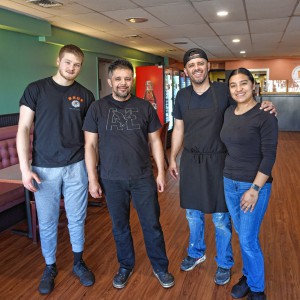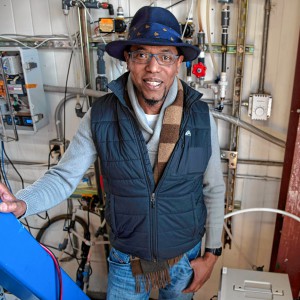‘We have to figure this out’: Educators wrestle with help, harm of ChatGPT
| Published: 02-07-2023 3:42 PM |
BOSTON — As educators and policymakers alike are learning to navigate a world in which artificial intelligence can write both high school essays and legislation, some in Massachusetts have embraced the controversial technology with open arms.
But while the chatbot that initially created buzz in tech circles is being used in the classroom and on Beacon Hill, Massachusetts’ education officials remain hesitant to talk about one of the latest AI breakthroughs.
ChatGPT, a machine learning tool that can generate human-like writing based on a prompt, launched at the end of November — free and easy to use for anyone with an internet connection. Users can give feedback or ask questions to tune responses, resulting in the chat-like format.
Despite national headlines about cheating concerns that popped up in online teachers’ forums in the early days of ChatGPT, when Nipmuc Regional High School life sciences teacher Bonnie Nieves first heard about the tool, she saw an opportunity for her students to think through research papers in a new way.
After getting back from winter break, Nieves assigned a research paper for her 10th grade class at the Upton school — but didn’t ask them to write it.
They conducted their research, documented it in notes, then put the notes through the AI language model with the instructions “compose a research paper about this topic.”
“It’s amazing, within 15 seconds it returned a full essay for the student. It still blows my mind,” Nieves said.
Students then proofread the essay ChatGPT created, checking for accuracy and adding new material it may have missed. They also added citations, Nieves said, and should be able to point to where each piece of information came from in their research notes.
Article continues after...
Yesterday's Most Read Articles
 Treehouse, Big Brothers Big Sisters turn race schedule snafu into positive
Treehouse, Big Brothers Big Sisters turn race schedule snafu into positive
 Northampton man will go to trial on first-degree murder charge after plea agreement talks break down
Northampton man will go to trial on first-degree murder charge after plea agreement talks break down
 Area property deed transfers, April 25
Area property deed transfers, April 25
 Contentious dispute ends as Hampshire Regional schools, union settle on contract
Contentious dispute ends as Hampshire Regional schools, union settle on contract
 South Hadley’s Lauren Marjanski signs National Letter of Intent to play soccer at Siena College
South Hadley’s Lauren Marjanski signs National Letter of Intent to play soccer at Siena College
 Primo Restaurant & Pizzeria in South Deerfield under new ownership
Primo Restaurant & Pizzeria in South Deerfield under new ownership
The AI tool works by using what is called a “deep learning language model” that has been trained on over 45 terabytes of text data, allowing it to generate human-like responses to user questions.
Based on the information it has “studied,” ChatGPT can create an epic poem that takes place on the set of “The Office,” put together a customized resume and cover letter, recommend a grocery shopping list — or, as many students around the world are using it, to write an essay.
But, since the tool is predicting what it believes the user wants to read based on source material that may or may not be accurate, outputs can be wrong or misleading. Nieves said this is one of the values of having her students learn how to use ChatGPT in her class, and why review is an important part of the process.
“This technology isn’t going anywhere,” she said. “When I was in school my teacher told me I had to learn to do math by hand because I wouldn’t always have a calculator with me. Well, now I do. And when spellcheck came out, teachers said, ‘You shouldn’t use spellcheck because you won’t learn how to spell.’ Now hardly anyone ever writes without it. I’d rather my students learn how to use this technology responsibly with me, because it’s here to stay.”
The final part of her students’ research paper process is putting their edited version of the essay back into the chatbot, asking for revisions and suggestions for improvement. The technology churns out writing recommendations in about 10 seconds, which Nieves said gives them much more usable, real-time feedback than when she collects the essays to look at over several days before returning them to students with her own suggestions.
“Now that they can get that feedback themselves, it gives them more ownership of the work they’re doing. They can decide whether or not they want to use the suggestions, which requires more critical thinking about what would actually improve their work than blindly taking a teacher’s recommendations,” the science teacher said.
Nieves said her students have “loved” working with ChatGPT in her class. Of the eight educators from across Massachusetts talked to for this article, all said their students know of the tool and use it often.
“When I overhear students saying something like, ‘Oh yeah, I used ChatGPT to write my English essay,’ I think, ‘You’re wasting it.’ It can be a learning tool to make you a better writer,” Nieves said.
But for some teachers, the new technology that Nieves describes poses a threat to student learning as well as an opportunity.
Bailey Tighe, a teacher at Walpole High School and a policy fellow for Teach Plus Massachusetts, an education nonprofit focused on helping teachers to learn about how state policy impacts the classroom, said when she first heard about the chatbot she was worried about technology replacing human skill.
“My initial impression of ChatGPT was fear,” she said. “I’m an English teacher and I taught ‘1984’ for a long time. In terms of the perspective of how much we let AI or technology persuade the direction of our lives — I haven’t taught that book in a couple of years, but maybe I’ll bring it back now.”
After learning more about it, Tighe said she is looking forward to finding ways to incorporatethe technology into her classroom in a positive way, but that the chatbot is causing teachers to reexamine how and what they assign.
“What needs to shift, and something I’ve already started in my own practice, is there has to be less assignments that are asking for a summary, because this can do that easily,” Tighe said. “If I want students to summarize a piece of text, that’s no longer something that I can assign. We have to do that in class together.”
Earlier this month, New York City Public Schools banned the AI chatbot across all devices and networks in the school system over plagiarism and cheating concerns.
Tighe feels confident that she can tell when a student hands in work that has been written by the AI, she said.
“It doesn’t exactly sound like a kid — I know how they write,” she said. “I don’t ever take points off for it, but I hand it back and point out, ‘This is not what the question is asking, I need you to tell me what you think about this, and you gave me a summary.’”
Along with several other educators, Tighe said ChatGPT could benefit students struggling with executive-functioning issues.
“One of the things, especially post-pandemic, that I noticed in my students is that they have so much anxiety getting started,” she said. “Their executive functioning in terms of starting tasks is really debilitating; they’re so hesitant to put anything down that may be wrong or to make a mistake. I could see this helping with that blank page anxiety.”
Robert Hendricks III, the founder of the Boston-based nonprofit He is Me, focused on helping Black men in teaching, said the tool could help students with disabilities or students who don’t speak English as a first language.
“Those two groups of students can, when they hand something in, look like they’re not learning whatever the content is. But the reality is, they’re struggling to represent what it is they do know. This can help them with that, it could give them content that’s at their level or in their language,” he said.
Still, Hendricks doesn’t think ChatGPT should be used on a broad scale in the classroom yet because of baked-in biases that it might be carrying over from the billions of pieces of text it has been trained on.
“That’s one of the biggest reasons why it shouldn’t be used yet,” Hendricks said. “I don’t think it’s fair to tell students, the system is set up against you or biased to not include you. Instead, we say, ‘How do we make that not the case as much as possible, and then introduce it to students?’”
Most of the teachers who are using ChatGPT in their classrooms are doing so on school computers with the teacher themselves inputting information, they said. According to the chatbot’s terms of use, you must be 18 years old to create an account to use the tool.
New York City remains somewhat alone so far in its move to ban ChatGPT in schools.
Massachusetts’ Board of Elementary and Secondary Education has yet to take up public discussion on the topic in its monthly meetings.
When asked in December if Department of Elementary and Secondary Education Commissioner Jeffrey Riley or then-Secretary of Education Jim Peyser had a comment on the use of the AI in schools, DESE press secretary Jacqueline Reis responded, “I’m afraid that neither are available.”
Asked again in February if DESE had a position on the new technology or recommendations for educators dealing with it in the classroom, Reis did not respond.
Requests for comment from the Massachusetts School Administator’s Association were also unreturned, and teachers unions — the Massachusetts Teachers Association and the American Federation of Teachers of Massachusetts — did not have anyone willing to discuss the topic.
Rebecca Ashley, president-elect of the New England Association of Teachers of English and head of the Canton High School English department, said that while the impact on the authenticity of student work is a major concern, she does not believe in banning its use.
“In a world where teachers compete with a constant stream of news, information, games, social media, etc., ChatGPT joins the ranks as another piece of technology that can be both helpful and harmful depending on its use,” she said. “As with any technology, educators will need to learn more, experiment with the technology, and see what its capabilities, shortcomings and pitfalls might be in the classroom and beyond.”
Meanwhile, on Beacon Hill, Sen. Barry Finegold may be able to claim a nationwide “first” by filing legislation drafted with the help of the AI.
Finegold’s bill seeks to help regulate ChatGPT and future, similar chatbots by requiring them to program the model to include a distinctive watermark that could be used to detect plagiarism, implement security and privacy measures to protect those using the tool, and register the model’s capacity, training data and intended use with the attorney general’s office.
“Where we failed with Facebook and some other stuff is that we never really worked with them and put in place proper guardrails, and I think because of that, it got abused,” Finegold said. “Companies are looking for us to kind of set up the parameters. I’m sure there’s going to be other companies that are doing this and they will be competitive. I think if we play referee as the government, then everyone’s going to know the rules of the game and the proper way to operate.”
Though Finegold’s legislation does not specifically regulate how the AI is used in schools, the Andover Democrat said the required watermarking included in the bill would help teachers identify papers written by the language model.
Open AI, the company that developed ChatGPT, has said it is working toward watermarking its AI-produced text.
Heidi MacGregor, Massachusetts Computer Using Educators President-elect and K-5 STEM integration specialist for Littleton Public Schools, said educators are going to need to learn how to work with the new technology if they want to help students succeed.
“We can categorically ban it and say you can’t use it, but we can’t control what happens on a home computer. If there’s a way to teach about it, explain to students how it works and explain to them what they’re getting into, we should,” she said. “We knew this was coming. Educators have always been tasked with keeping up with the times, and this is here to stay. We have to figure it out.”

 Federal probe targets UMass response to anti-Arab incidents
Federal probe targets UMass response to anti-Arab incidents Locking up carbon for good: Easthampton inventor’s CO2 removal system turns biomass into biochar
Locking up carbon for good: Easthampton inventor’s CO2 removal system turns biomass into biochar William Strickland, a longtime civil rights activist, scholar and friend of Malcolm X, has died
William Strickland, a longtime civil rights activist, scholar and friend of Malcolm X, has died Advancing water treatment: UMass startup Elateq Inc. wins state grant to deploy new technology
Advancing water treatment: UMass startup Elateq Inc. wins state grant to deploy new technology
